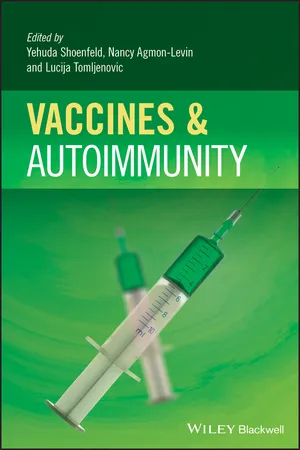
Vaccines and Autoimmunity
- English
- ePUB (mobile friendly)
- Available on iOS & Android
About this book
In light of the discovery of Autoimmune Syndrome Induced by Adjuvants, or ASIA, Vaccines and Autoimmunity explores the role of adjuvants – specifically aluminum in different vaccines – and how they can induce diverse autoimmune clinical manifestations in genetically prone individuals.
Vaccines and Autoimmunity is divided into three sections; the first contextualizes the role of adjuvants in the framework of autoimmunity, covering the mechanism of action of adjuvants, experimental models of adjuvant induced autoimmune diseases, infections as adjuvants, the Gulf War Syndrome, sick-building syndrome (SBS), safe vaccines, toll-like receptors, TLRS in vaccines, pesticides as adjuvants, oil as adjuvant, mercury, aluminum and autoimmunity. The following section reviews literature on vaccines that have induced autoimmune conditions such as MMR and HBV, among others. The final section covers diseases in which vaccines were known to be the solicitor – for instance, systemic lupus erythematosus – and whether it can be induced by vaccines for MMR, HBV, HCV, and others.
Edited by leaders in the field, Vaccines and Autoimmunity is an invaluable resource for advanced students and researchers working in pathogenic and epidemiological studies.
Frequently asked questions
- Essential is ideal for learners and professionals who enjoy exploring a wide range of subjects. Access the Essential Library with 800,000+ trusted titles and best-sellers across business, personal growth, and the humanities. Includes unlimited reading time and Standard Read Aloud voice.
- Complete: Perfect for advanced learners and researchers needing full, unrestricted access. Unlock 1.4M+ books across hundreds of subjects, including academic and specialized titles. The Complete Plan also includes advanced features like Premium Read Aloud and Research Assistant.
Please note we cannot support devices running on iOS 13 and Android 7 or earlier. Learn more about using the app.
Information
Part I
Mosaic of Autoimmunity
Chapter 1
Role of Adjuvants in Infection and Autoimmunity
Introduction
The different types of adjuvants
Aluminum salts
Oil-based adjuvants
Virosomes
Novel and experimental adjuvants
Toll-like receptor-related adjuvants
New formulated adjuvants
Table of contents
- Cover
- Title Page
- Copyright
- Table of Contents
- Contributors
- Introduction
- Part I: Mosaic of Autoimmunity
- Part II: Studies on Autoimmune Conditions Induced by Vaccination
- Part III: Autoimmune Diseases Solicited by Vaccination
- Index
- End User License Agreement